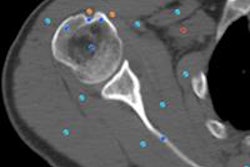
Smartphone photos of patient injuries can be a useful complement to an imaging study, but it's not easy to incorporate them into the patient record. Researchers from the University of Applied Sciences of Western Switzerland believe they may have a solution to the problem.
The research group has developed a prototype of a Web-based mobile application that can quickly add patient information, upload and annotate images, and share the images with other users of the application. They could also be exported to a patient record.
"Taking the pictures and adding them to a patient record can, in our opinion, have an added clinical value; the information is complementary to radiology imaging, and it is common practice to take such pictures in some domains," said Henning Müller, PhD.
Müller and colleagues described their prototype app during a presentation at the Medinfo 2013 meeting last month in Copenhagen, Denmark.
 A Web-based application can provide secure mobile upload of pictures from a smartphone camera directly to a database and share the images with other clinicians. The photos can also be exported to the patient record. Image courtesy of Henning Müller, PhD.
A Web-based application can provide secure mobile upload of pictures from a smartphone camera directly to a database and share the images with other clinicians. The photos can also be exported to the patient record. Image courtesy of Henning Müller, PhD.
In discussions with radiologists in private practices, Müller learned that radiologists are increasingly taking pictures of patients as a complement to radiological imaging. These photos could be of swelling after an accident or the outer view of an open fracture, for example.
This concept "can also be extended to many other situations [such as] where emergency drivers can take pictures of positions of patients at an accident scene and transmit them to the hospital to get a first idea about severity of the accident and potential problems," Müller told AuntMinnieEurope.com.
While the photos can be easily taken on personal smartphones, the pictures aren't often connected to a patient ID or patient record, he said.
HTML5
As a result, the researchers sought to create a mobile app that could better incorporate these external images into patient records. Because the goal was to build a prototype that could be used on iPhones, Android-based devices, and other smartphones, the researchers chose to develop a Web-based application based on HTML5.
The Web-based application allows pictures to be uploaded directly from any smartphone camera, and it's also possible to take pictures offline and upload them later, he said.
Personal profiles can be set up on the application for each user, and the application supports uploading of patient images as well as metadata.
"Images can then be shared with other users and potentially be exported to the patient record if judged interesting or important," he explained.
The application can upload any type of picture: "These can be pictures from a wound or an accident scene, but also images that the patients brought such as older x-rays, obviously with limitations in quality," Müller said.
Complement to radiology
Müller noted that the information in these patient photos is complementary to radiology imaging.
"We still need to explore in which situation this clinical added value could be high and, as such, be of particular interest," he said. "This [idea] is not only for radiologists, but also for other physicians such as surgeons or emergency medicine where this can help. Also, dermatology could be an interesting field to explore."
The application is a prototype and has not been tested clinically. The researchers would be happy to have partners to test it and give feedback on improvements, Müller added.
"This was a student project and, as such, not funded research," he said. "We would really like to develop this further, as we think that there is an interesting potential, but we would require collaborations for this or some funding to explore it further and run clinical tests maybe in a limited set of situations."



















